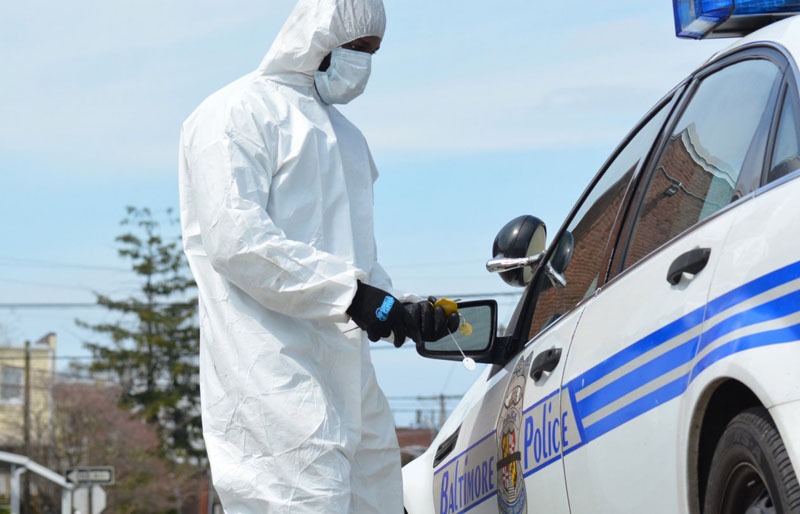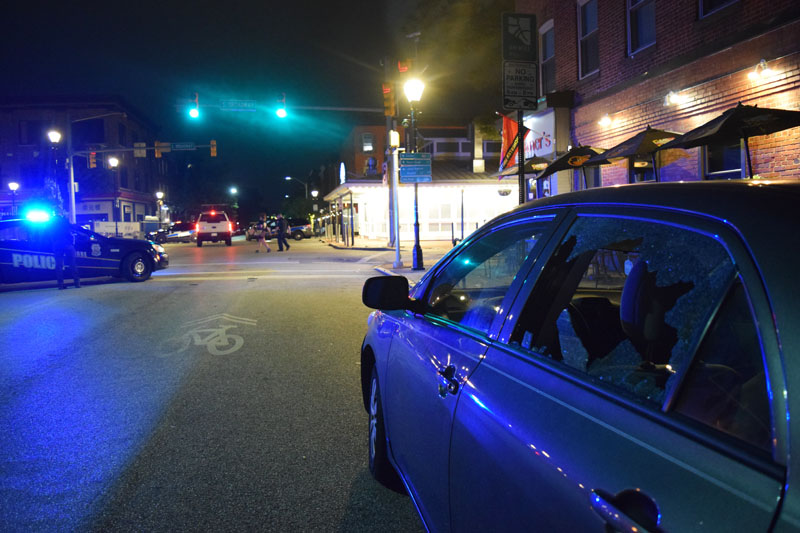Baltimore Goes Dark: Police Scanner Encryption Creates New Danger
Police activity in Baltimore will soon be concealed by the shroud of an encrypted radio system. This new equipment will allow officers to work without worrying about whether a crafty criminal is listening to their security tactics. But it poses a security threat to hundreds of thousands of city residents by blinding them to the crimes happening around them.
In the beginning, there was the pandemic, the dark days of loneliness—a time period when Baltimore slowly suffocated beneath a shroud of uncertainty. Its citizens had been asked to hide inside their homes. Its businesses had closed. The fear of the deadly coronavirus circulating through restaurants and stores that once provided food and entertainment to the city’s residents turned Baltimore into a modern-day Pompeii. An unexpected event had caused catastrophic damage and left hundreds of thousands of people in a frozen state of existence—the last moments of their former lives memorialized by their last normal day as human beings roaming the earth with lives, jobs, and a sense of purpose. There were no normal days after that. There were only more days. Then the days turned into weeks, the weeks turned into months, and the months turned into a year. Eventually, the city’s citizens began to leave their frozen state to explore potential solutions to the pandemic. They wore face masks to ward off the possibility of sharing the virus. They complied with new guidelines, new laws, and new fears tied to the possibility of contracting the virus by touching the wrong door or breathing in the wrong pocket of air. Many of them took a chance on a variety of vaccines, embracing the slim possibility of a life-threatening reaction in exchange for the opportunity to return to their old lives.

In the end, there was encryption, the dark days of information reduction—a time period when Baltimore’s residents were stripped of their ability to see what police officers were doing in their neighborhoods. The police department planned to use a new radio system to shield the communication of its officer. Under encryption, the city’s citizens no longer had to hide inside their homes but, in some ways, could no longer see the world around them. Its businesses would be run by owners who could no longer operate them with some understanding of the type of criminal activity that was occurring in their surrounding environment. The fear of the coronavirus had finally abated, easing the pressure associated with financial insecurity. But in some ways, this new impending phase was worse than the pandemic because with the inception of encryption came a collective realization that the dark days in Baltimore would not end.

Towards the end, it became clear how blind the city’s citizens would eventually become. In that last month, before the scanner went dark, there was a triple shooting in the heart of Fells Point, one of Baltimore’s wealthiest neighborhoods. Fells Point was pressed up against the harbor. Its multitude of restaurants and bars made it a magnet for people who planned friendly gatherings and boozehounds who loved to hop from bar to bar. Its businesses had struggled through the economic recession associated with the pandemic and finally received permission from Maryland Gov. Larry Hogan (R) to resume normal operations in mid-May. The shooting occurred in the early hours of June 6, fewer than four weeks after the green light to proceed to normalcy had been given to the state’s business sector. Some of the police officers present in the area when bullets began to fly thought the popping sounds associated with them were the hallmark snap of fireworks.
“It’s just fireworks,” one officer noted.
“I’m not sure about the armed person call but the push that we just had out of here was some fireworks,” another agreed.
Seconds later, one of the highest-ranking officers on duty alerted the others to the shooting. Three men had been shot. They were all transported to a local hospital by 1 a.m. An hour after the shooting, however, police were still struggling to keep the bar crowd at bay. Yellow strips of crime scene tape were strewn everywhere as if a drunken spider had decided to leave a somewhat incomprehensible love note for his female companion: Meet me at Max’s Taphouse. Only no one would be meeting anyone anywhere. Police were pushing the party crowd north and playing whack-a-mole with bar-hoppers who didn’t want to go around the crime scene tape. People were drunkenly stumbling past the shell casings and crime lab technicians who were prepared to protect the evidence at all cost. It was the greatest show on earth.

In the following days, local politicians would pay a heavy price for those theatrics. Business owners desperate for dollars following an economic draught were outraged. Was crime so out of control in the city that people couldn’t partake in the popular weekend pastime of debauchery and committing the occasional sin? What would it take to address this problem? The solution was a widely attended Zoom meeting and a plan to assign additional police officers to patrol the area. It seemed like a great plan—until there was a shooting the following weekend. That’s when some people began to ponder whether there was any real solution at all.
On June 13, multiple gunshots rang out again in the heart of Fells Point. Security camera footage obtained by the Baltimore Sun shows a woman reacting to a sound, realizing that she’s hearing bullets flying out of a gun chamber, and running. Suddenly, everyone around the woman starts running, seeking shelter from an unexpected storm of adrenaline-fueled violence. The barrage of bullets strikes cars and buildings but the intended target or targets escape unscathed. Police initially believed that a person who arrived at one of the local hospitals had possibly sustained injuries from the shooting and had requested a crime lab technician to process the crime scene but that theory proved not to be true. Although a crime lab technician did show up to the sprawling crime scene, his services were unwarranted because no one had been injured during the shooting. Police sent him back to the forensics lab and, after thoroughly searching for dozens of shell casings tucked away in the dark crevices of the street, collected the evidence themselves.

The sun rose over Fells Point long after the crime scene tape had been stripped away. People in posh houses arose from their slumber, unaware of the shooting that had occurred down the street. The Baltimore Police Department did not release a press statement containing details of the event. Why would it? No one had been injured. The department prides itself on keeping the public abreast of critical incidents involving people who had been shot or someone who has been fatally stabbed. Many crimes fall below that critical-incident threshold though and this was one of them. This was property damage. Property damage via stray bullets is incredibly common in Baltimore. It would be ridiculous to expect the police department to update the public every time a would-be criminal didn’t get away with a crime simply because they missed their target and hit a parked car or first-floor window.

During the pandemic, overnight crimes in parts of the city known for attracting tourists or bar crowds had become frequent events. The shootings on June 6 and June 13 were followed by a third shooting in Fells Point on August 10. A 35-year-old man was shot in the leg that night. Days later, on August 12, an armed man pointed a gun at a group of people near the Baltimore Police Department headquarters around 12:30 a.m. One of the nearby officers saw him, chased him, and shot him. Two days after that, on August 14, someone gunned down a 28-year-old man and a 33-year-old man near that headquarters building around 2:50 a.m. After the sun rose, police searched the area where the two men had been shot again and found the shell casings responsible for damaging their bodies in a pool of water leftover from when firefighters had washed away the blood from their injuries. These shootings were a part of an extraordinary trend of violent crimes committed near police in parts of town where there were multiple bystanders who either saw what was happening, didn’t want to see what was happening, or could have gotten hurt.

But that’s the lynch-pin argument against encryption: in the early hours in the morning, when most people are sleeping and most local reporters aren’t working, a variety of events could unfold and, if those events don’t meet a certain threshold, then no one would know about them. It could even happen during the day while local reporters are working.
That was the case on June 14. Police were reacting to pockets of violence throughout the city, subduing flickers of trouble before they became flames that fed chaos. Around 7:10 p.m., they were informed that someone had used a gun to take a white Honda Pilot from a pizza delivery man in the 1800 block of Druid Hill Avenue. The person who committed the carjacking made the grave mistake of stealing a vehicle while the police department’s helicopter, known as Foxtrot, was flying over the city. It wasn’t difficult for Foxtrot to track down the carjacker, who happened to be a sixteen-year-old kid. The Foxtrot crew watched from the air as the teenager ditched the stolen vehicle in the 1000 block of N. Fremont Avenue and it slowly rolled into a parked dump truck. The teenager ran off with a pizza box, tossed the box, pulled off his sweatshirt, and then walked casually because he had greatly underestimated the helicopter’s camera technology. In under a minute, he was running again because the police had caught up with him. Some of the officers chased him on foot. Some of them drove their vehicles. The teenager dodged into an alleyway, ran past a vacant house, and then tried to cut through an empty lot full of overgrown grass and weeds.

